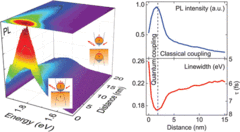Control of plasmon emission and dynamics at the transition from classical to quantum coupling
| Reviews and Highlights | Quantum Science | Molecular and Soft-matter | Ultrafast Nano-optics and Nanophotonics | Mineralogy and Geochemistry |
|---|
Vasily Kravtsov, Samuel Berweger, Joanna M. Atkin, and Markus B. Raschke
Nano Lett. 14, 5270 (2014).
DOI PDF

With nanosecond radiative lifetimes, quenching dominates over enhancement for conventional fluorescence emitters near metal interfaces. We explore the fundamentally distinct behavior of photoluminescence (PL) with few-femtosecond radiative lifetimes of a coupled plasmonic emitter. Controlling the emitter−surface distance with subnanometer precision by combining atomic force and scanning tunneling distance control, we explore the unique behavior of plasmon dynamics at the transition from long-range classical resonant energy transfer to quantum coupling. Because of the ultrafast radiative plasmon emission, classical quenching is completely suppressed. Field-enhanced behavior dominates until the onset of quantum coupling dramatically reduces emission intensity and field enhancement, as verified in concomitant tip-enhanced Raman measurements. The entire distance behavior from tens of nanometers to subnanometers can be described using a phenomenological rate equation model and highlights the new degrees of freedom in radiation control enabled by an ultrafast radiative emitter near surfaces.
